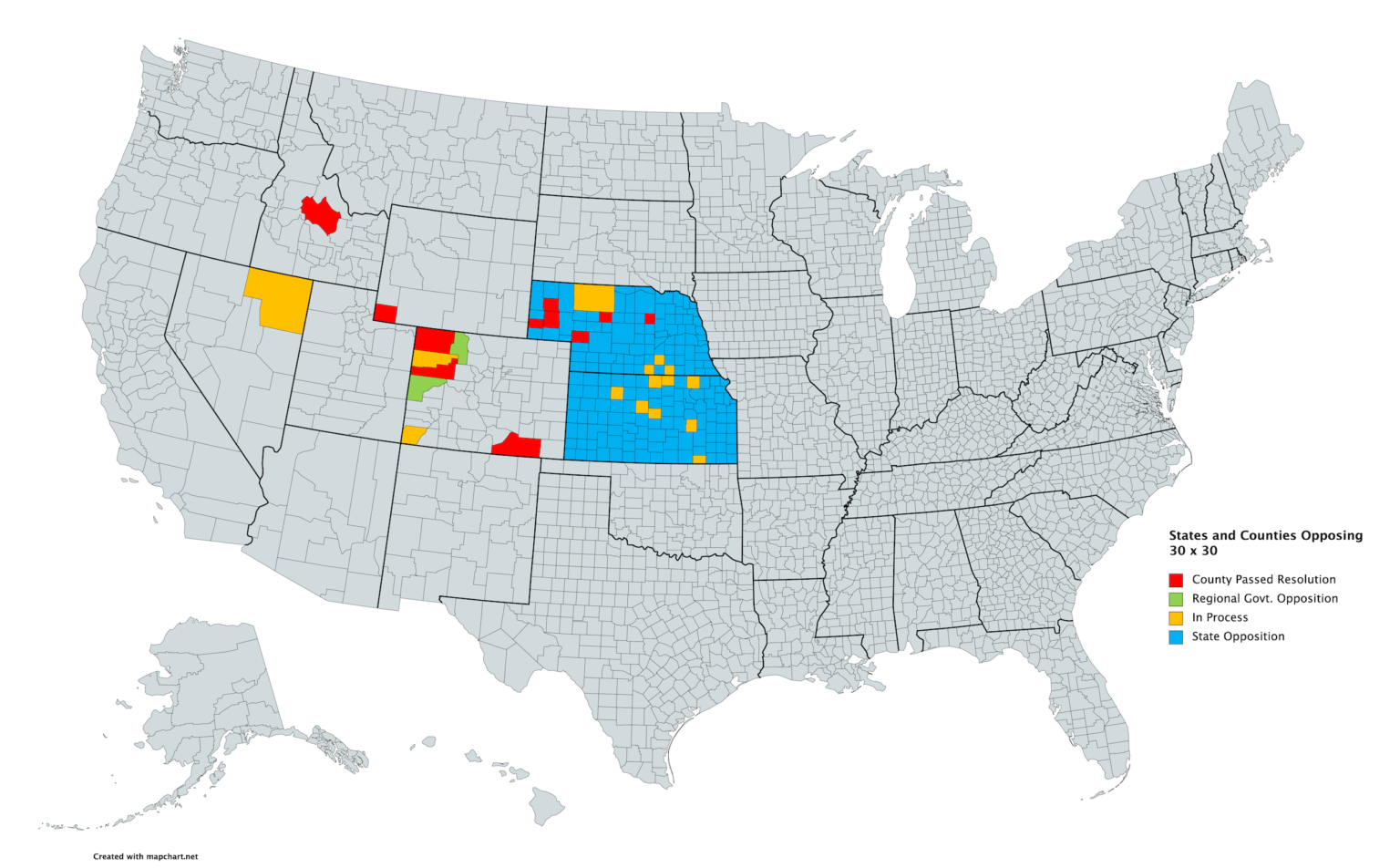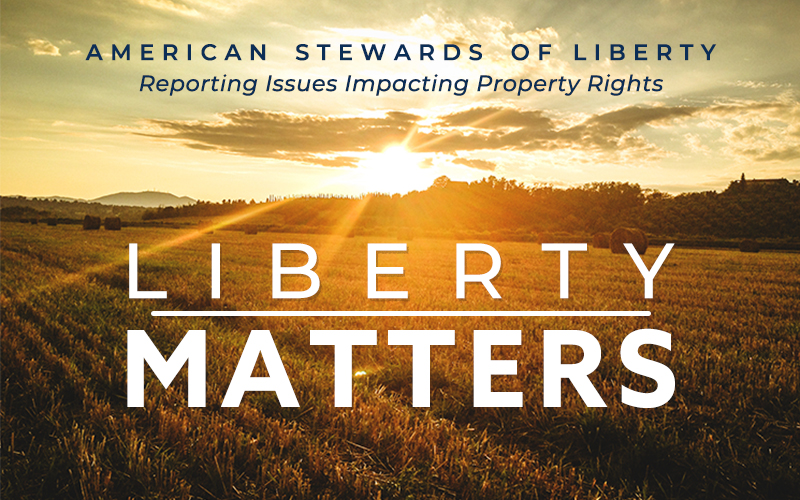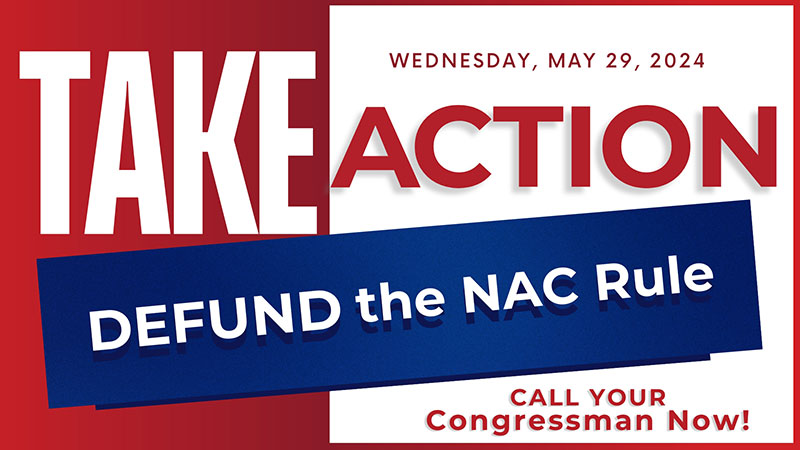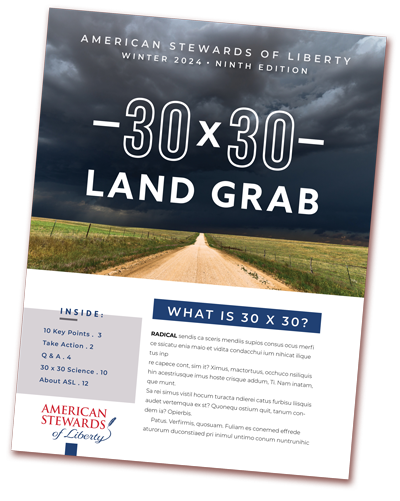In this issue…
Update on Campaign Opposing 30 x 30
NE and KS Attorneys General’s Warn Biden
Administration of Federal Overreach
The Carrot and Stick Behind 30 x 30
Upcoming 30 x 30 Events
Update on Campaign Opposing 30 x 30
The groundswell of opposition to 30 x 30 is growing from the center of the nation outward. Ten Counties have been confirmed as completing the Resolution process with policies in place opposing the program. Fifteen Counties are currently completing their Resolutions, and many more are just getting started. Two States have put the Executive Branch on notice that they will challenge Federal overreach, and 62 Members of Congress have signed a letter opposing 30 x 30.
Go here to see the maps and whether you County, State, U.S. Representative or Senator has taken a stand opposing 30 x 30. If they have not, make sure you contact them and ask that they do. If we have missed noting others who have opposed, please let us know.
Nebraska and Kansas AG’s Warn Biden Administration of Federal Overreach on 30 x 30
On April 8, 2021, the Nebraska and Kansas State Attorneys General co-signed a letter to the Secretary of Interior stating that they are prepared to defend their state’s and landowners’ property rights from the 30 x 30 program.
Noting the Biden Administration’s lack of detail and transparency about the program, they stated:
“As state attorneys general, we write to seek your assurance that full protections for private property rights will be maintained as the details of this presidential directive are being considered. It is unclear from the ambiguous language of the Executive Order what is meant by ‘conserving at least 30 percent of our lands and waters.’ We are greatly concerned this proposal could include the taking of additional land and water into federal control.”
The Attorneys General emphasized that they are closely watching the Administration’s efforts to implement 30 x 30 and are ready to defend the rights of their states and its citizens, if necessary.
“‘This 30 by 30’ provision in the Executive Order appears to represent yet another federal overreach into private property rights and state and local authority. America does not have, nor does it want, a centrally planned economy. Rest assured, we will be closely monitoring the actions taken in response to this presidential directive and will take action as necessary to protect private property rights and the role of states in land and water management decisions.”
Norman James, an attorney with Fennemore Craig, points out that the states are on strong footing, especially in light of the Supreme Court’s recognition of the rights of states to regulate land and water uses. One example is Solid Waste Agency of Northern Cook County v. U.S. Army Corps of Engineers, 531 U.S. 159 (2001). That decision addressed EPA and the Corps of Engineers interpretation of “waters of the U.S.” under the Clean Water Act, which extended federal jurisdiction to intrastate waters used by migratory birds.
The court, in holding that the agencies had exceeded their authority, found that the rule would interfere with the states’ traditional powers over land and water use: “[P]ermitting respondents to claim federal jurisdiction over ponds and mudflats falling within the ‘Migratory Bird Rule’ would result in a significant impingement of the States’ traditional and primary power over land and water use.”
The Supreme Court cited another decision, Hess v. Port Authority Trans-Hudson Corporation, 513 U.S. 30, 44 (1994), in which the court similarly explained that “regulation of land use [is] a function traditionally performed by local governments.”
The AG‘s letter is a significant development, reaffirming the concerns landowners have that the program could infringe on private rights. Instead of waiting for the Biden Administration to provide details on how it intends to reach the 30 percent goal, the AG’s are already asserting their commitment to defend the constitutional limitations placed on the federal government and protect the rights of state and local governments to decide how land and water may be used.
The Carrot and Stick Behind 30 x 30
The White House continues to withhold substantive details on the 30 x 30 initiative set forth in the Climate Crisis Executive Order (EO 14008), and signed January 27th. However, they are already moving forward on what appears to be pieces of the program through the release of funding for conservation programs, proposed budget priorities, and tax code changes.
In response to the letter signed by 62 Congressional Members opposing the program, the White House provided staff members with a briefing that included a short ten minute presentation and a round of questions. While Congressional Staff focused on asking specifics as to the level of conservation efforts applied to lands that will be counted toward the 30 x 30 goal, and what vehicles the administration intends to use to reach that goal, the White House indicated these decisions have yet to be made.
They did confirm they are planning to use all the tools in the toolbox, noting specifically the Antiquities Act when asked directly about this vehicle, which the President can use to unilaterally withdraw lands, avoiding Congressional or public approval. They also made clear that private lands will be included in the program and are seen as necessary to reach the goal. However, they “triple underlined” that any program to include private lands would be “voluntary.”
The White House staff emphasized the report they are developing for the Task Force will be a “high level” report, which was taken to imply it may not include substantive details, but instead focus on major objectives of the program. The Department of Interior is directed to deliver the implementation plan to the National Climate Task Force by April 27, 2021.
Although the EO directs the Departments to work with States and local governments, there has been no effort to reach out to those who have made specific requests and voiced their early opposition. However, there are many reports of the Departments meeting with environmental and recreational groups. Specifically, Garfield County, Colorado issued their meeting request March 8th, over a month ago, but have not received a response.
Meanwhile, the Administration has wasted little time launching partnerships with environmental land trusts who are working to convince landowners to enroll private acreage in programs they oversee under the federal provisions. The conservation easement in perpetuity is their preferred vehicle. This device requires the land trust or federal government to obtain primary control over the land for conservation purposes, effectively changing the nature of the property from private to federal, given the landowner no longer controls the management of the land. Instead, the land is managed to comply with restrictive federal laws and policies, such as the Endangered Species Act. Because of this, the Department of Interior considers these lands permanently protected, and includes them along with wilderness areas, National and State Parks and National Wildlife Refuges, towards the current 12 percent of lands already protected. (See DOI Fact Sheet)
The Administration announced two programs last week to encourage private landowners to enroll in the new federal conservation policy that will be monitored primarily through the Natural Resource Conservation Service (NRCS). The first is the Working Lands for Wildlife Framework, focusing on the Sagebrush and Prairie Lands in the West. The second is a partnership with The Nature Conservancy, the world’s largest land trust. Again, details are slim, but the NRCS/TNC release states they have signed a cooperative agreement to work together in the states of Kansas, Missouri, Nebraska, Oklahoma and South Dakota.
Biden’s budget priorities are even more intriguing. Under the Administration’s budget discretionary request, released April 9, 2021, they included funding for the 30 x 30 program, without revealing more than general policy objectives.
For the Department of Agriculture, the budget statement is:
“In support of the goal of conserving 30 percent of land and water by 2030, the discretionary request includes significant investments within the Forest Service and the Natural Resources Conservation Service to support the health and resilience of public and private lands. These investments would encourage voluntary conservation across the Nation’s forests, farms, and ranches, while allowing land owners to continue to work their land, which complements the innovative conservation efforts that States and the agriculture community are pursuing.” (President’s request for fiscal year 2022 discretionary funding, Enclosure 2, page 2)
For the Department of Interior, the budget request is slightly more specific:
“The discretionary request provides an additional $200 million for science-driven conservation to align management of the Nation’s natural resources with America’s climate, biodiversity, and clean energy needs. This investment would support the goal of conserving 30 percent of land and water by 2030, including through voluntary actions and incentives that support the stewardship efforts of farmers, ranchers and other private landowners. The discretionary request would also support the Civilian Climate Corps to develop the next generation of conservation workers and create a new pathway to good-paying jobs.” (Enclosure 2, page 20)
While it appears the Administration is focused on working closely with private landowners, through voluntary programs that promise extra funding to the land rich and cash poor industries, they are also wielding a heavy stick. To pay for the department budget increases, new infrastructure goals, and welfare programs rolled out over the last month, the Administration and Democrat Congressional Members are proposing major changes to the tax code.
One of these changes includes getting rid of the “step-up” provision that is triggered when land is passed onto heirs. It significantly reduces the estate tax an heir would pay when land passes to the next generation, allowing the land and business to stay in the family. If this provision is eliminated, as is currently being proposed, few sons and daughters will be able to hang on to the family’s land. The estate taxes will be so prohibitive that they will need to sell all or some of the land to pay the tax bill, or, big surprise here, place it in a conservation easement in perpetuity to reduce the tax burden. Either way, the government ends up controlling the land.
Of course, they want to assure private landowners that their 30 x 30 program is completely voluntary, actually “triple” underline “voluntary.” But when they design the system so landowners are forced to relinquish their private property rights, is that truly voluntary? Or does it mirror the feudal land system our forefathers rejected, instead prioritizing individuals, not government, owning the land.
If all these new policy pieces emerge as currently designed, the Administration could reach their short-term goal of 30 x 30 quickly, well on their way to achieving their long-term goal of 50 x 50.
Upcoming 30 x 30 Events
Learn more about the new Administration’s 30 x 30 program and what you can do to protect your land and community. We will be in Nebraska, Oklahoma, Montana, South Dakota, Colorado, New Mexico and Texas in April and May. We hope to see you on the road. See Schedule.





